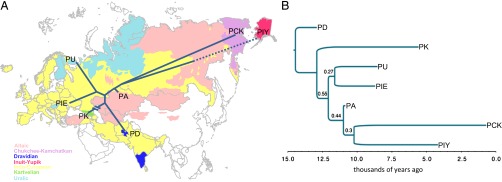Fig. 4.

Consensus phylogenetic tree of Eurasiatic superfamily (A) superimposed on Eurasia and (B) rooted tree with estimated dates of origin of families and of superfamily. (A) Unrooted consensus tree with branch lengths (solid lines) shown to scale and illustrating the correspondence between the tree and the contemporary north-south and east-west geographical positions of these language families. Abbreviations: P (proto) followed by initials of language family: PD, proto-Dravidian; PK, proto-Kartvelian; PU, proto-Uralic; PIE, proto–Indo-European; PA, proto-Altaic; PCK, proto–Chukchi-Kamchatkan; PIY, proto–Inuit-Yupik. The dotted line to PIY extends the inferred branch length into the area in which Inuit-Yupik languages are currently spoken: it is not a measure of divergence. The cross-hatched line to PK indicates that branch has been shortened (compare with B). The branch to proto-Dravidian ends in an area that Dravidian populations are thought to have occupied before the arrival of Indo-Europeans (see main text). (B) Consensus tree rooted using proto-Dravidian as the outgroup. The age at the root is 14.45 ± 1.75 kya (95% CI = 11.72–18.38 kya) or a slightly older 15.61 ± 2.29 kya (95% CI = 11.72–20.40 kya) if the tree is rooted with proto-Kartvelian. The age assumes midpoint rooting along the branch leading to proto-Dravidian (rooting closer to PD would produce an older root, and vice versa), and takes into account uncertainty around proto–Indo-European date of 8,700 ± 544 (SD) y following ref. 35 and the PCK date of 692 ± 67 (SD) y ago (SI Text).
